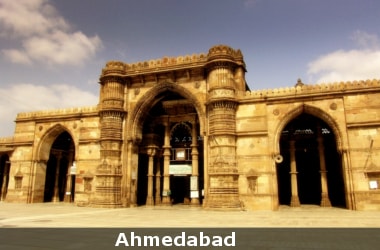▼ Ahmedabad on UNESCO list! [07-11-17]
 UN cultural agency Unesco on 8th July 2017 declared the 600-year-old walled city of Ahmedabad as a world heritage city, the first Indian city to make it to the list. UN cultural agency Unesco on 8th July 2017 declared the 600-year-old walled city of Ahmedabad as a world heritage city, the first Indian city to make it to the list.
The World Heritage Committee of Unesco met in Karlow, Poland on Saturday night where the decision was made.
This journey began in 2010 when Prime Minister Narendra Modi proffered the dossier of Ahmedabad to Unesco.
With this title, the Walled City of Ahmedabad has joined Paris, Vienna, Cairo, Brussels, Rome and Edinburgh.
Of the 287 world heritage cities across the globe, the only two cities in the Indian subcontinent which enjoy the status are Bhaktapur in Nepal and Galle in Sri Lanka.
The committee also added Asmara, the capital of Eritrea, to its list of World Heritage sites on Saturday. Earlier on Friday, it added Hebron-Al Khalil Old Town (Palestine) and W-Arly-Pendjari Complex (Benin, Burkina Faso) to the list.
It also added the site of Hebron-Al Khalil to the list of World Heritage Sites in Danger.
For over 600 years, Ahmedabad has stood for peace, as a landmark city where Mahatma Gandhi began India’s freedom struggle.
It has stood for unity with its elegant carvings in its Hindu and Jain temples as well as standing as one of the finest examples of Indo-Islamic architecture and Hindu Muslim art.
And beyond this, it epitomizes the United Nation’s objective of sustainable development as it accelerates in its development, chosen to be one of India’s first smart cities, while preserving its ancient heritage.
The nomination of Ahmedabad was supported by about 20 countries including Turkey, Lebanon, Tunisia, Portugal, Peru, Croatia, Zimbabwe, Tanzania, South Korea, Croatia, Cuba and Poland.
Ahmedabad’s journey towards attaining a world heritage tag began in 1984 when the first study for conserving heritage structures was instituted by Ford Foundation.
In March 2011, Ahmedabad made it to Unesco’s tentative list of world heritage sites.
In January 2016, it was chosen over Delhi and Mumbai as India’s entry for the title.
Ahmedabad has about 25 ASI (Archaeological Survey of India)-protected structures, hundreds of ‘pols’(housing clusters in the walled city areas of Ahmedabad) that capture the essence of community living, and numerous sites associated with Gandhi, who lived here from 1915 to 1930.
This makes the walled city of Ahmedabad the first city in India and the third in Asia to be inscribed to the World Heritage List. In the past 3 years alone, India has managed to put five built heritage sites on the world heritage list of UNESCO.
India now has overall 36 World Heritage Inscriptions with 28 Cultural, 07 Natural and 01 Mixed site.
While India stands second largest in number after China in terms of number of world heritage properties in ASPAC (Asia and Pacific) region, it is overall seventh in the world.
Ahmedabad: Know More
- Founded in 15th century, the walled city of Ahmadabad, on the eastern bank of the Sabarmati river, presents a rich architectural heritage.
- Within this complex are 28 ASI Centrally Protected Monuments.
- The urban structures of the historic city of Ahmedabad are distinctive due to their puras (neighbourhoods), pols (residential streets), and khadki (inner entrances to pols) largely made of timber.
- The historic architecture reflects symbols and myths connected with its inhabitants.
- The urban fabric is made up of densely-packed traditional houses (pols) in gated traditional streets (puras) with characteristic features such as bird feeders, public wells and religious institutions.
- It is a unique example of multi-religious and multicultural coexistence.
- The inscription has been done under Criteria (ii) and (v) as defined in the UNESCO's Operational Guidelines, 2016. Criterion (ii) refers to the important interchange of human values, over a span of time on development of architecture, monumental arts, town planning and landscape while Criterion (v) refers to being an outstanding example of human settlement and land use.
- Thus, the acceptance of the proposal highlights historic city of Ahmedabad's exemplary settlement architecture and town planning.
|
▼ Oldest mummy unearthed in China [07-3-17]
 China has unearthed the mummified remains of a middle-aged man on a less frequented section of the ancient Silk Road on the edge of China’s Qinghai-Tibet plateau. China has unearthed the mummified remains of a middle-aged man on a less frequented section of the ancient Silk Road on the edge of China’s Qinghai-Tibet plateau.
The mummy is believed to be 1,700 years old. It was found at a construction site in the town of Mang’ai.
It is perhaps the oldest and the best-preserved mummy discovered on the Qinghai-Tibet Plateau.
The body measures 1.62 metres and features perfectly preserved skin and hair remnants. The body is believed to have belonged to a man in his 40s.
To know further about the man’s ethnicity and identity, archaeologists will conduct DNA tests. Besides this, the mummy was found amidst dried reeds, dyed cloth mats, a horse’s hoof, and sheep bones, all of which were thought to be funeral objects for the upper class of the time.
The area where the body was found is on the northern edge of the plateau close to Taklamakan Desert, on a less travelled off-shoot route of the ancient Silk Road.
Traders took this route to avoid conflict on the Hexi Corridor, the much-popular main road.
Mummies are usually formed in very dry environments which prevent bodies from decay.
|